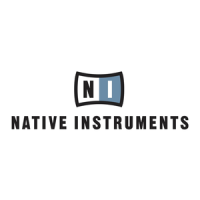KONTAKT PLAYER Getting Started – 16
•
Purge: Opens a drop-down menu of options related to the purge facility, which allows you
to temporarily unload samples from memory that are currently not in use.
3.2 The Rack
The Rack is the part of KONTAKT’s user interface that takes up the most screen space; it’s the
large area below the Main Control panel. Whenever you load an Instrument, it will appear in
the form of a horizontal header here. As the name suggests, the Rack is designed to resemble
a stack of 19” studio equipment; that is, any additional Instruments will appear alongside the
headers that are already there. This way, you can easily load up to 64 Instruments (distributed
across pages of 16 each) at the same time into a KONTAKT instance. Such a combination of
Instruments is called a Multi, and you can save and recall it just like an Instrument.
When you rst start KONTAKT, the Rack will be just an empty space, indicating that no
Instruments are currently loaded. You’ll need to either load an Instrument, or open a Multi.
Chapter 4.1 of this guide explains how you nd and load existing Instruments from the sound
libraries on your hard disk.
The Rack header controls.
On top of the Rack, you‘ll nd a row of user controls; most of these don‘t actually change
anything in your Multi, but affect which kinds of information will be visible in the Rack. Next
to a text line that shows the name of your currently loaded Multi, there are four page buttons
that allow you to navigate to one of the Rack pages of 16 Instruments each.
3.3 Browser
The Browser is the vertical pane on the left side of the window, right next to the Rack; if you
don’t see it, click on the Browse button in the Main Control panel to make it show up.
The main purpose of the Browser is to gather functions that let you organize and browse any
number of KONTAKT-relevant les in a variety of different ways. Among other things, you

